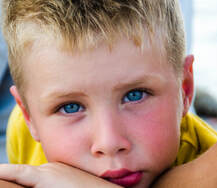|
Eye problems in kids can cause further consequences. For example, if a child has problems with vision, it can interfere with learning. In some cases, self-esteem and social development may also be affected. Recognizing pediatric eye conditions as soon as possible helps parents get their child the treatment they need. Eye Diseases and Conditions in Children and How They are TreatedThere are several eye diseases and conditions in children, including those listed below: Strabismus Strabismus involves misalignment of the eyes. It is commonly also called cross-eyed. It might be that an eye turns inward, upward, downward, or outward. The eye might be misaligned constantly or only intermittently. It can develop anytime in childhood from infancy on up. The cause of strabismus can vary and can include a medical condition, such as cerebral palsy. Children that have a family history of strabismus are also at an increased risk. Treatment may include wearing an eye patch, surgery, and eyeglasses. In some cases, Botox injections may also help. Leukocoria Leukocoria, or “white pupil,” is often first noticed by family members or in photographs. It is an abnormal white reflection from the retina of the eye and can be a sign of retinoblastoma, a rare form of cancer that rapidly develops in the retina. Leukocoria can also be associated with a number of other conditions, including strabismus. So, it is very important to have your eye doctor evaluate your eyes promptly if you notice an abnormal white, rather than a normal red, reflection from your eye. Lazy Eye The medical term for a lazy eye is amblyopia. It occurs when one eye is weaker than the other. According to the American Academy of Ophthalmology, it is a common condition in children. It can develop due to other eye problems, such as refractory errors. Treatment often includes wearing an eye patch over the stronger eye to make the child use the weaker eye. Eye drops or eyeglasses that blur the vision of the stronger eye may also help strengthen the other eye. It may take several months for treatment to work. Refractive Errors Refractive errors are also common eye conditions in children and can include nearsightedness (myopia), farsightedness (hyperopia), and astigmatism. Farsightedness involves being able to see things at a distance more clearly than objects that are near. Nearsightedness is the opposite. Children that are nearsighted can see objects that are near clearer than distant objects. Astigmatism is also a type of refractive error that occurs due to an uneven curvature of the cornea. The curvature affects the way light enters the eye and causes blurred vision. Pediatric Cataracts A pediatric cataract involves a clouding of the lens in the eye. Normally, the lens is clear. When it becomes cloudy, it can lead to blurred vision. Some pediatric cataracts are present in infancy, and others develop sometime during childhood. Pediatric cataracts can develop for unknown reasons or as a result of infections and genetic diseases. Surgery is often successful in treating childhood cataracts. Recognizing SymptomsIt’s vital that parents and caregivers spot signs of pediatric eye problems before they become more severe. In many cases, conditions are easily treated and don’t lead to permanent vision issues. Signs that your child may have an eye problem include:
If your child has any of the above symptoms, he/she should be evaluated by an eye doctor as soon as possible. Understanding Your Child’s RiskSome children are at an increased risk of developing certain eye conditions and diseases. Understanding your child’s risk helps you to be on the lookout for certain symptoms. Although any child can develop vision or eye problems, there are certain factors that may increase their risk, including the following:
Preventing Eye Diseases in ChildrenIt may not be possible to prevent all childhood eye problems, but some measures can be taken. It’s important for pregnant women to avoid smoking. Encouraging children to eat healthily and exercise decreases their risk of type 2 diabetes. Type 2 diabetes occurs in children and raises their risk of some eye problems.
Even if your child is not at an increased risk of vision problems, an age-appropriate vision screening is important. The American Academy of Ophthalmology recommends children have a vision screening when they are newborns, infants, preschoolers, and elementary school age. If you would like to schedule a routine exam or you have any questions about your child’s eyes, please phone our office at 508-746-8600. Comments are closed.
|
EYE HEALTH BLOGCategories
All
Archives
April 2024
|
|
Kadrmas Eye Care New England
55 Commerce Way, Plymouth, MA 02360
14 Tobey Road, Wareham, MA 02571 133 Falmouth Road (Rt 28), Mashpee, MA 02649 |
Phone Number:
1-508-746-8600 Hours: Monday through Friday — 8 AM – 4:30 PM |


 RSS Feed
RSS Feed
